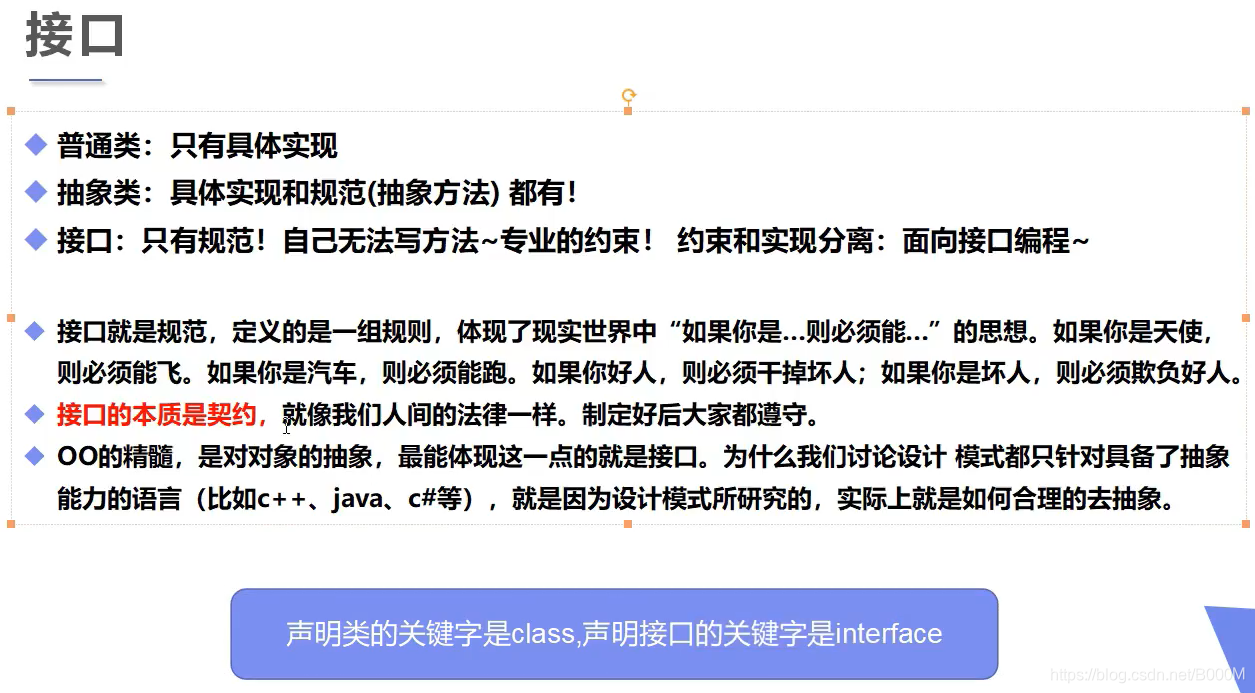面向对象编程
面向对象编程
面向对象编程的本质就是:以类的方式组织代码,以对象的方式封装数据。
- 抽象
- 三大特征
- 封装
- 继承
- 多态
类与对象的创建
package oop.demo01;//学生类public class Student { //属性:字段 String name; int age; //方法: public void study(){ System.out.println(this.name+"在学习"); }}测试:
package oop.demo01;//一个项目应该只有一个main方法public class Application { public static void main(String[] args) { //类:抽象的,实例化 //类实例化后会返回一个自己的对象! //student对象就是一个Student类的实例!//==========Student========== Student xiaoming = new Student(); Student xiaohong = new Student(); xiaoming.name = "ming"; xiaoming.age = 18; xiaohong.name = "hong"; xiaohong.age = 18; System.out.println(xiaoming.name); System.out.println(xiaoming.age); System.out.println(xiaohong.name); System.out.println(xiaohong.age); xiaoming.study(); }}构造器
Java中的构造方法是一种特殊的方法,用于初始化对象。Java构造函数在对象创建时被调用。它构造值,即提供对象的数据。
- 和类名相同
- 没有返回值
作用:
- new本质在调用方法
- 初始化对象的值
注意点:
- 定义有参构造之后,如果想使用无参构造,显示的定义一个无参构造
package oop.demo01;public class Person { //一个类即使什么都没写,它也会存在一个方法 //显示的定义构造器 String name; //实例化初始值 //1.使用new关键字,本质实在调用构造器 //2.用来初始化值 public Person(){ } //有参构造 public Person(String name){ this.name = name; } //alt+insert}测试:
package oop.demo01;//一个项目应该只有一个main方法public class Application { public static void main(String[] args) { //==========Person========== Person person = new Person("yang"); System.out.println(person.name); }}类与对象
- 类与对象
-
类是一个模板:抽象;
-
对象是一个具体的实例
- 对象的引用
对象是通过引用来操作的:栈—>堆(地址)
-
属性:字段Field成员变量
默认初始化:
数字: 0 0.0
char: u0000
boolean: false
引用: null
修饰符 属性类型 属性名 = 属性值
-
类:
静态的属性 属性
动态的方法 方法
封装
(数据的隐藏)
-
该漏的漏,该藏的藏
-
高内聚,低耦合
-
属性私有,get/set
意义:
- 提高程序安全性,保护数据
- 隐藏代码实现细节
- 统一接口
- 系统可维护性
public class Student { //属性私有 private String name; private int age; private char sex; //提供一些操作这些属性的方法 //提供一些public的get、set方法 //get 获得这个数据 public String getName() { return name; } //set 给这数据设置值 public void setName(String name) { this.name = name; } public int getAge() { return age; } public void setAge(int age) { this.age = age; } public char getSex() { return sex; } public void setSex(char sex) { this.sex = sex; }}import oop.demo02.Student;public class Application { public static void main(String[] args) { Student s1 = new Student(); s1.setName("yang"); System.out.println(s1.getName()); s1.setAge(18); System.out.println(s1.getAge()); }}继承
继承的本质是对某一批类的抽象,从而实现对现实世界的更好建模
extands意思是“扩展”。子类是父类的扩展。
(在Java中,所有关系,都默认直接或间接继承object)
public class Person { private int money = 10_0000_0000; public void say(){ System.out.println("say"); } public int getMoney() { return money; } public void setMoney(int money) { this.money = money; }}Java中类只有单继承,没有多继承!一个儿子只能有一个爸爸,但是一个爸爸可以有多个儿子
super
super:
- super调用父类的构造方法,必须在构造方法的第一个
- super必须只能出现在子类的方法或者构造方法中
- super 和 this 不能同时调用构造方法
Vs this:
代表对象不同
this:本身调用者这个对象
super:代表父类对象的应用
前提
this:没有继承也可以使用
super:只能在继承条件才可以使用
构造方法
this():本类的构造
super():父类的构造
方法的重写
需要有继承关系,子类重写父类的方法
-
方法名必须相同
-
参数列表也必须相同
-
修饰符:范围可以扩大,但不能缩小 public>Protected>Default>private
-
抛出的异常:范围,可以被缩小,但不能扩大
Exception(大)—> ClassNotFoundException
重写,子类的方法和父类必要一致:方法体不同
为什么需要重写:
- 父类的功能,子类不一定需要,或者不一定满足
A:
package oop.demo04;public class A extends B{ //注解:有功能的注解 @Override public void test() { System.out.println("A=>test()"); }}B:
package oop.demo04;//重写是方法的重写,和属性无关public class B { public void test() { System.out.println("B=>test()"); }}Application:
import oop.demo03.Student;import oop.demo04.A;import oop.demo04.B;public class Application { public static void main(String[] args) { //静态的方法和非静态的方法区别很大 //静态方法:方法的调用之和左边定义的数据类型有关 //非静态:重写 A a = new A(); a.test(); //A //父类的引用指向了子类 B b = new A(); //子类重写了父类的方法 b.test(); //B }}多态
注意事项:
-
多态是方法的多态,属性没有多态
-
父类和子类,有联系 类型转换异常 ClassCastException
-
存在条件:继承关系,方法需重写,父类的引用指向子类对象 Father f1 = new Son();
- static 方法,属于类,它不属于实例
- final 常量;
- private 方法;
Person
package oop.demo05;public class Person { public void run(){ System.out.println("run"); }}Student
package oop.demo05;public class Student extends Person{ @Override public void run() { System.out.println("son"); } public void eat() { System.out.println("eat"); }}Application
package oop;import oop.demo05.Person;import oop.demo05.Student;public class Application { public static void main(String[] args) { //可以指向的引用类型就不确定了:父类的引用指向子类 //Student 能调用的方法都是自己的或者继承父类的 Student s1 = new Student(); //Person 父类型,可以指向子类,但不能调用子类独有的方法 Person s2 = new Student(); Object s3 = new Student(); s2.run(); s1.run(); //对象能执行哪些方法,主要看对象左边的类型,和右边关系不大 ((Student) s2).eat(); s1.eat();instanceof
instanceof 严格来说是Java中的一个双目运算符,用来测试一个对象是否出现在某个实例对象的原型链上。
(它的作用是测试它左边的对象是否是它右边的类的实例)
import oop.demo05.Person;import oop.demo05.Student;import oop.demo05.Teacher;public class Application { public static void main(String[] args) { Object obj = new Student(); System.out.println(obj instanceof Student);//true System.out.println(obj instanceof Person);//true System.out.println(obj instanceof Object);//true System.out.println(obj instanceof Teacher);//false System.out.println(obj instanceof String);//false System.out.println("====================="); Person per = new Student(); System.out.println(per instanceof Student);//true System.out.println(per instanceof Person);//true System.out.println(per instanceof Object);//true System.out.println(per instanceof Teacher);//false //System.out.println(per instanceof String); System.out.println("====================="); Student stu = new Student(); System.out.println(stu instanceof Student);//true System.out.println(stu instanceof Person);//true System.out.println(stu instanceof Object);//true //System.out.println(stu instanceof Teacher); //System.out.println(stu instanceof String); }}类型转换
- 父类引用指向子类对象
- 把子类转换成父类,向上转型(不用强转)
- 把父类转换成子类,向下转型(强转)可能会丢失一些方法
- 方便方法的调用,减少重复的代码
抽象的编程思想:封装、继承、多态
抽象类
abstract , 抽象方法,只有方法名字,没有方法的实现!
- 不能new这个抽象类,只能靠子类去实现它;约束!
- 抽象类中可以写普通方法
- 抽象方法必须在抽象类中
//抽象的抽象:约束
接口

package oop.demo06;//interface 定义的关键字,接口都需要有实现类public interface UserService { //接口中的所有定义其实都是抽象的 public abstract void add(String name); void delete(String name); void update(String name); void query(String name);}package oop.demo06;public interface TimeService { void timer();}package oop.demo06;//抽象类: extends//类: 可以实现接口 implements 接口public class UserServiceImpl implements UserService,TimeService{ @Override public void add(String name) { } @Override public void delete(String name) { } @Override public void update(String name) { } @Override public void query(String name) { } @Override public void timer() { }}作用:
- 约束
- 定义一些方法,让不同的人实现
- public abstract
- public static final
- 接口不能被实例化,接口中没有构造方法
- implements可以实现多个接口
- 必须要重写接口中的方法
内部类
- 成员内部类
package oop.demo07;public class Outer { private int id = 10; public void out(){ System.out.println("wai"); } public class Inner{ public void in(){ System.out.println("nei"); } //获得外部私有属性以及方法 public void getID(){ out(); System.out.println(id); } }}package oop;import oop.demo07.Outer;public class Application { public static void main(String[] args) {Outer outer = new Outer(); //通过这个外部类来实例化内部类 Outer.Inner inner = outer.new Inner(); inner.in(); inner.getID(); }}- 局部内部类
package oop.demo07;public class Outer { //局部内部类 public void method(){ class Inner{ public void in(){ } } } }//获得外部私有属性以及方法 public void getID(){ out(); System.out.println(id); } }}package oop;import oop.demo07.Outer;public class Application { public static void main(String[] args) {Outer outer = new Outer(); //通过这个外部类来实例化内部类 Outer.Inner inner = outer.new Inner(); inner.in(); inner.getID(); }}- 局部内部类
package oop.demo07;public class Outer { //局部内部类 public void method(){ class Inner{ public void in(){ } } } }

